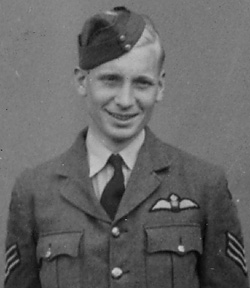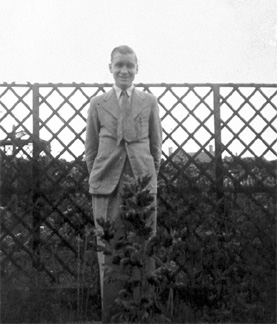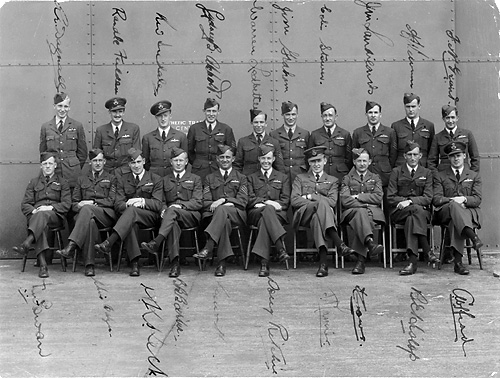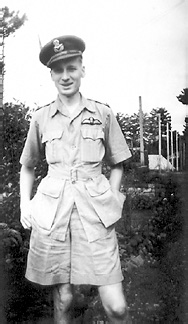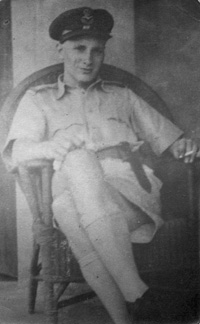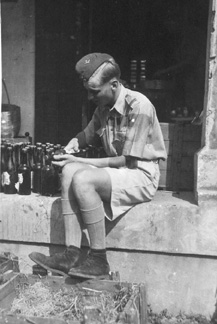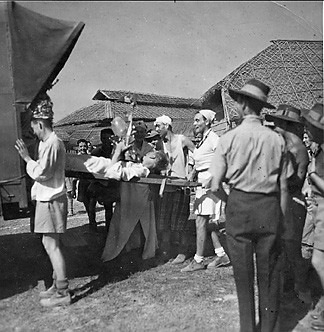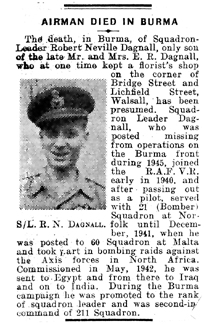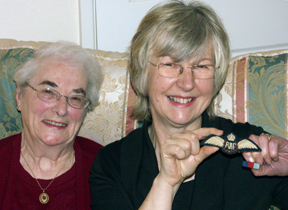 |
 |
||||||||||
|
S/Ldr Robert Neville DAGNALL 121532 RAFVR: KIA 13 January 1945 Robert Dagnall was born on 2 March 1920 in Walsall, Staffordshire. He and sister Gwen grew up in the Black Country town where his parents Ernest and Edith kept a flower shop. Mr & Mrs Hazledine next door were close family friends, Hazledine himself having stood as best man for Dagnall senior.
Tall, fair and cheerful. With a jaunty cock of the head, the new Sergeant pilot in best blues with wings and stripes up, on completion of flying training in early July 1941. From the 2 SFTS course photo, below. When the Dagnalls later moved South to Bournemouth, Robert continued to visit Walsall to stay with the Hazledines. The couple had no children of their own and in turn, Mrs Hazledine became just as close to the children of her new neighbours, the Ellis family. In time, two of the young people from these families were also to became close friends, as we shall see.
Here Robert is aged 17, the grin unmistakable. The gay garden trellis setting hints at his height: 6’ 2”. Leaving school at Bournemouth in 1934, young Robert was soon to make his own way in the world. By 1938 he was working as an order clerk with a major plumbing and heating firm in Bristol, Arthur Scull & Son. The firm had weathered the Great Depression in sound shape and was soon to make its own contribution to the war-effort, building industrial-scale plumbing and heating for shadow aircraft factories, on airfields, in military hospitals and elsewhere, and later in post-war reconstruction. The firm continued to prosper as a separate entity into the early 1960s, and survives today as part of the Drake and Scull international conglomerate. Boys in blue While RAF practice gave him the beginner’s lowly rank of Aircraftman 2nd Class, he was immediately mustered as Aircraft Hand/Pilot. If he could pass through the training to come, Bob was thus set for that part of the Air Force with the otherwise pedestrian title, the General Duties Branch, in the most desirable job: aircrew. First, though, came his formal introduction to the baffling ways of the Service. Funnelled through a series of postings he was sent straight to 9 Recruits Centre Blackpool for a month for kitting out, then on to 1 Receiving Wing for trainee aircrew at Babbacombe for a fortnight and finally, as Winter neared, on to 2 Initial Training Wing at Cambridge for the start his aircrew training, on the ground at least, from 12 November 1940. He advanced to Leading Aircraftman on 5 January 1941, almost at once re-mustering as U/T Pilot—in the jargon of the RAF Form 543A—or Pilot Under Training. Having successfully passed all the hurdles of a highly selective system so far, in February LAC Dagnall moved on to 50 Group Pool at Yatesbury. Formed in February 1939 as part of the expanding training effort of the RAF, 50 Group of Flying Training Command was already responsible for a number of Elementary Flying Training Schools and Air Navigation Schools in the West Country. The 50 Group Pool also performed some of the initial flying training, borrowing Tiger Moths from 10 EFTS at Bristol—a School operated by none other than the Bristol Aeroplane Co. In any event, apparently at 50 Group Pool rather than any of its EFTS elements, Bob Dagnall progressed satisfactorily in his eight weeks flying training, being posted straight on to 2 Service Flying Training School with effect from 26 April 1941, just over seven months since his enlistment. Captain of Aircraft and Pilot First established as early as 1921, by September 1937 No 2 SFTS had taken up residence at Brize Norton with large numbers of North American Harvards and Airspeed Oxfords on the books. In June 1940, 2 SFTS dropped its single-engine work to concentrate on Group II (twin-engine) training with a roster of over 100 Oxfords. In what was to be a busy Spring and Summer at Brize Norton, in late May 1941 Robert Dagnall began a neat diary using a scrounged Workshop notebook (RAF Form 620, the official mind requiring an orderly and orderable identity for everything). Well into his first year of RAF war service but with just two months flying under his belt, Dagnall’s first diary entry of 25 May 1941 was both matter-of-fact about his flight, yet careful to note his status as Captain of Aircraft and Pilot. Taking turn about as Pilot & CA vs Navigator with his opposite number, LAC BA Adams, in six hours of cross-country flying in poor weather they got lost only once. And if it was Robert’s compass-setting error, he was able to fly them out of trouble by his own careful observation and with some judicious course correction (perhaps on Adams’ part). Several other crews force-landed that day, with the low rack of cloud at times down to 600ft. Dagnall was not best pleased by stalling-in two days later, apparently in Airspeed Oxford P1878, with minor damage to wing and undercarriage in muddy conditions. A week later and he was wrestling another aircraft whose undercart was reluctant to lock down. Week by week, he recorded the highs and lows of his flying, up to six hours a day, in bad weather and good, by day and by night, as Pilot and Captain of Aircraft or as Navigator, the exercise successfully carried out or ending in the odd ground-loop or hedge, all noted in the diary with an eye to that reflective self-assessment which the Pilot’s Flying Log Book did not generally permit. Often flying with Adams, by the third week of June he was approaching the milestone of 120hrs in the log. In 1940 that could have been more than enough to get him posted to an operational Squadron. As the 2 SFTS course continued, they got a taste of formation flying, of bombing exercises, and of night flying, sticking at it despite the odd misadventure and despite the sobering loss of two other trainees in a more serious accident. They were far from alone in encountering difficulty and danger in the effort of RAF training. Yet as June passed, so did the weather improve, as did their skill and confidence. And Robert Dagnall’s diary entries became first breezier, then briefer and finally, on 29 June 1941, they ceased. The reason, perhaps, is to be found in two typically terse notations on his Airman’s Record of Service for the same day: promotion to Sergeant and mustered as Pilot, both with effect from 2 July 1941. In well under a year of service, he had reached a significant milestone, Sergeant Pilot in the RAF.
Officers and sergeants alike, with their much-coveted pilot’s wings. Sgt RN Dagnall is the tallest man standing at the rear, far left. No date or course board, but every participant has signed Dagnall’s copy. This can hardly be other than the 2 SFTS course photo of successful trainees from their 10 week course, completed about 2 July 1941 at Brize Norton. Adams is not present: in the highly selective assessment system he may been remustered as a Navigator. At RAF Bicester in Oxfordshire, No 13 Operational Training Unit had formed in April 1940 to train Blenheim crews. By mid-1941, their equipment roster included a rather large contingent of Blenheim IVs. There the new Sergeant pilot was posted on 6 July 1941, for what at that time was the last step before reaching a front-line Squadron. At Bicester and at Hinton, Bob Dagnall spent the late summer of 1941 with 13 OTU on 38 Course. Shortly after his departure, Devenish, Joerin and Mockridge arrived for their training—all later to serve with 211 Squadron. And so to war This second full year of the war had been very testing: if the Battle Of Britain had clearly been won, the Luftwaffe’s Night Blitz over British towns continued with rising civilian losses until May 1941. The Bismarck was sunk that month but the Battle of the Atlantic wore on, with increasingly heavy loss of shipping and merchant seamen to the U-boats. Meanwhile in the Middle East, as the siege of Malta and repeated struggle across the Western Desert dragged on, in sombre counterpoint first Greece and then Crete fell to Axis forces. For Britain and the Commonwealth, although it was to take another year of war before military casualties overtook civilian loss of life, all three Services remained at full stretch in defence, both at Home and abroad. And just thus had 21 Squadron gathered much war experience, operating with its Mark IV Blenheims variously from its main station at Watton in Norfolk, from Lossiemouth in the North of Scotland on detachment to Coastal Command, and on short detachments to reinforce Malta from as early as April 1941. Dagnall was posted to join them at Watton, remaining there until December 1941. His first sortie of the war came on 31 October. With Don “Bruno” Brown as Observer and Bert Friendy in the turret of Bristol Blenheim IV Z7354 O-Orange, they completed a 5 hour anti-shipping patrol without incident. A month later and the three were flying on a Circus to bomb the Luftwaffe at Morlaix airfield, again returning safely. At year’s end, his annual assessment offered a real boost: not only rated as Very Good in character but also as Superior in proficiency as a Pilot, a grading that implied readiness for promotion. A Mediterranean interlude The exposed position of the Island fortress was difficult for all concerned, not least for the Blenheim units undertaking forward offensive sorties like shipping sweeps and strikes against Palermo Harbour. By the second week of February 1942, 21 Squadron had lost 11 aircraft and their crews, 33 men in all, of whom just three survived as PoW. The dead and missing included their CO W/Cdr WR Selkirk and crew, lost on 4 February 1942. Over the period from 15 January to 31 January, Sgt Dagnall and his crew had completed a further 6 offensive sorties and a radar calibration flight, again without incident. They were now an experienced crew, with 10 operations in all to their credit. If the change in strategic balance had seemed slight when Germany invaded Russia, the impact of the Japanese attacks of 7 December 1941 was both swift and large. As 21 Squadron prepared to withdraw from Malta, Singapore fell. Despite the pressure at sea, at Home, and in the Mediterranean—and for air power in each theatre—more now had to be found for the Far East as well. The 21 Squadron Air Party reached the relative safety of Egypt on 23 February 1942. In the first week of March, awaiting the outcome of his application for a commission, Sgt Dagnall began another diary, carefully titling and dating the cover of the plain, non-issue, lined notebook. The first page he headed with his name, service no and rank, much later returning to update it with the gazettal of his commission. The rest of the first two pages of the new diary he started to fill with a dated, running list of RAF Stations visited. On 6 March 1942, Dagnall arrived by air at that plum of RAF Middle East permanent stations, Heliopolis. By 21 March, most of the Squadron’s remaining groundcrew had also arrived in Egypt from Malta, presumably courtesy of the Royal Navy. At this point, 21 Squadron had been taken rather by surprise. Although deservedly being rested after their battering at Malta, they disliked the result: detached to RAF Middle East instead of returning Home, yet apparently no immediate prospect of operational work. Unsure of their next duty, the aircrew soon became somewhat impatient of the bright lights of Cairo. Whatever their hopes as a unit, their Middle East deployment was in fact at an end. RAF Records had already noted Dagnall as posted to Middle East Pool from 28 February, though the disbanding of the Squadron and dispersal of aircrew to other units seems to have been rather a protracted affair as they waited for postings, interspersed only occasionally with non-operational flying. Indian journey Many a man in India found the frequent posting delays and muddles testing. Dagnall’s diary gives some insight into the inward struggle of a sometimes introspective serviceman determined to keep at it though in uncertain health. While his daily jottings became less frequent, he continued to keep careful track of his travels. Perhaps some leave was due, or perhaps he was ill: for whatever reason, by 23 April he had travelled by rail all the way back to Lahore. The war must have seemed very far away. There followed a dispiriting period in India, where the rapid withdrawal of forces from Malaya and Burma had come with heavy loss, resulting in an amount of disorganisation, a lack of equipment and, for Dagnall, prolonged periods without flying plus continuing uncertainty about substantive posting. At the end of May he left Lahore for Asansol, 100 miles or so East of Calcutta, where 60 Squadron were now based with their scraped together Blenheim IV force. To 60 Squadron That same day finally brought the formal notice of his commission. The London Gazette can be difficult to coax into revealing results, but there the record of Dagnall’s progress is to be found, in the grant of his commission as Pilot Officer with effect from the previous February: London Gazette Issue 35592, 9 June 1942
Recently commissioned, in tropicals, rings on the shoulder tabs not quite visible, the young officer pilot again in jaunty mood in India, though looking very slim now. Perhaps this is a clue to a date from late June 1942. The long delayed notification brought about a clerical quirk that today helps shed slightly more light on his service, while casting a little confusion too. Of necessity, his RAF Form 543A Record of Service as an airman had continued to run until late June 1942. Only then, formally commissioned, could the Records clerks create his AM Form 1406 Officer’s Record of Service. In order to correctly back-date it to the start of his commission five months before, the scribblies referred back to earlier and fuller records that are no longer available for study. So, for example, the Airman’s Form shows where and when Dagnall was hospitalised, while his Officer’s Form gives more detail of illness but less on place. And while his Sergeant’s record is clear on the 60 Squadron posting date, his Officer’s form records it as back in Egypt, dated 1 April 1942. Thus the fog of war, in which no account or record, then or now, can give entirely complete and unequivocal details of daily affairs. Such inconsistencies are by no means uncommon. It is not apparent from his fairly full diary remarks in the Middle East that the air ferry task had been part of any formal posting, while his sparser comments in India reflect continuing uncertainty about posting. So it may well be that his Sergeant’s record is the right version, in recording what was happening at the time in accord with his own diary record of movements, rather than the later, recompiled, Officer’s record of what may once have been intended. Posted to 60 Squadron but clearly ill, from June until late August he wrote nothing, except the bare notes of his travel dates, all exhaustingly by rail, and from one end of war-time India to the other. At the end of June he was back in Calcutta. Still in poor health, he travelled by rail to Shillong in the Assam hills for a fortnight, before being sent back across the sub-continent to Lahore for a Medical Board in mid-July. This time they found him temporarily unfit for either flying or ground duty and packed him off for another month’s rest, to Murree on the far North-West Frontier, once home to 31 Squadron. In mid-August, he reported back to New Delhi, where they decided he was well enough to resume desk work. They let him fly back to Asansol. On 25 August he had been a week back with his Squadron, working as Welfare Officer and chafing at the lack of flying. After another trip to New Delhi, in late September he was finally passed as A1B: fully fit for flying and other duties. On operations
Certainly after commissioning, and possibly as Flying Officer, in India. Gazettal to Flying Officer rank came on 4 December 1942, with effect from 1 October. It is certain that he was back on operations with 60 Squadron at Asansol in October. On the 6th, 60 Squadron put up two Blenheims on an armed reconnaissance out beyond the Chin Hills: to Gangaw for Dagnall and his crew, and to Kalewa for Morphett and co. The results were excellent, and drew a rare direct accolade: a signal of congratulations to the two named pilots and their crews from the AOC Bengal, AVM DF Stevenson OBE DSO MC & Bar. From September to December 1942, he continued flying with 60 Squadron at Asansol, moving with them to Jessore that month, and on to Dohazari in the New Year, his own travel list coinciding with other accounts of 60 Squadron movements and destinations. Frank Harbord DFM, author of the delightful Familiar Voices, was then a W/O Navigator with 60 Squadron and about to be commissioned. He remembers Dagnall arriving at Asansol and on the move to Yelahanka, recorded elsewhere as May 1943. By then their Blenheim IVs were very tired and in the 1943 monsoon season it was time for the Squadron to stand-down and change role. In May, they left Dohazari for Yelahanka and St Thomas Mount, where they were to re-equip with single-seat Hurricanes for ground attack work. Time, therefore, for wholesale re-posting of the Blenheim crews, too.
It seems likely that Dagnall would by then have been due for a move after his long 60 Squadron stint, perhaps to a succession of staff or training jobs. In any event, in April 1943 he had made a decided choice, drawing his occasional diary entries to a firm close. Curiously, his list of travel dates and stations continued until the end of 1943. Guns and rockets It was 8 September before he arrived at Bhopal. There 1 AGS had a wonderfully mixed bag of aircraft, from sagging Audaxes on through almost the gamut of RAF kit: the Hart, the Hurricane (in numerous Marks), the Wellington, Lysander, Blenheim V, Liberator, Vengeance and even the Defiant (in Target Tug role). His time with 1 AGS may have been a real pleasure: his duty with them recorded as flying (as opposed to Staff work) but in November and December he was ill again, possibly with malaria. By mid December he had recovered. By now he was a sporadic correspondent with family, too. However, two letters that survive from 1944 gave clues to his movements, since confirmed by his RAF Record of Service. From late March 1944 to the end of May he was at 3 Refresher Flying Unit, then at Poona - a more productive unit title and function than its previous existence as the dreaded Aircrew Transit Pool (and all the languishing in frustration that hints at). As 3 RFU at least they had a variety of aircraft to keep aircrew "current", including Beaufighters. His duty with them is unclear, though it may have included conversion to the Beaufighter. However galling or pleasing this period may have been, it was also not without reward: London Gazette Issue 36417, 7 March 1944 By May 1944, F/Lt Dagnall was getting ready for his third operational Squadron posting. Back in Bengal at the Special Low Attack Instructors School (SLAIS) at Ranchi, its sole purpose was the rocketry course for Beaufighter and Hurricane pilots—smoke and thunder to be had there, all right. He'd seen a lot of action by then, at Home and at Malta with 21 Squadron, and on Burma operations with 60 Squadron. Chiringa and 211 Squadron It was about this time that Frank Harbord, now a Flying Officer with the DFM, met Bob Dagnall once more. At the Grand Hotel Calcutta, where airmen often stayed, Dagnall asked Harbord to come to 211 Squadron and fly with him. Though clued up on Dagnall’s ability, Frank was unable to accept: the Beaufighter needed a Navigator/Wireless in the back seat but Harbord had only qualified as a plain Navigator. The 211 Squadron Operations Record Book (ORB) entries for Dagnall start with his arrival from Ranchi on 2 September 1944 as F/Lt, along with Martineau (also later S/Ldr in the Squadron). From 25 October, he was made acting Squadron Leader, and a Flight Commander of the Squadron. The ORB records his steady accumulation of 21 sorties, most of them with Flight Sgt CL Rogers as his Navigator/Wireless (from then until December 1944), and in January 1945 with F/O Ronald Henry Stenning 152683. The ORB, usually a dry official daily record, carried a faithful account of the Squadron's Christmas 1944 hijinks, including the usual souvenir menu (signed by Dagnall, now acting CO) and a number of delightfully informal “official” photographs.
The acting CO “stretchered” with much mirth to the fancy dress Christmas football match by a tender mob of “ambulance drivers” and “nurses”. The high spirits of the day were well photographed and I am indebted to Peter Spooner (and his son Phil) for good scans from his own splendid print collection. While many of these were included in the ORB, retrieving useful images from photocopies off archive microfilm is a chancy business at best. In January 1945 the Squadron was busy with a Rocket Projectile course at Ranchi for the first 10 days or so of the month, S/Ldr Dagnall leading the main detachment of 13 pilots there. Resuming operations on Friday 12 January 1945, the Squadron was at once busy, with 10 aircraft on patrol (two over the Irrawaddy and eight in the Taungyup area). At this time, XXXIII Corps had managed to advance across the Irrawaddy against resistance by the Japanese 15th Army. In support, the RAF—with 211 Squadron in the strike-fighter role—was very active against Japanese targets and supply lines. Ground attack work was inherently dangerous, for a variety of reasons apart from interception (engine failure, ground fire, low-slung wire traps against river attacks and so forth). While all 211 Squadron aircraft returned safely after an intensive and successful period of patrolling that day, three had been damaged by ground fire. in Beaufighter Mark X NE603 'O', S/Ldr Dagnall and his Navigator F/O Stenning were struck by machine gun fire near the navigator's station (but without injury to Stenning). It was Dagnall’s 20th sortie with 211 Squadron, his first with Stenning as Nav/W. The next day, Saturday 13 January, Dagnall and Stenning were third crew to patrol, once again flying aircraft NE603 'O'. Armed with rockets they took off at 1010 hours, tasked to take over the earlier patrolling of the rail line from Taikkyi to Iniwa and attack any targets of opportunity. However, the aircraft failed to return. No signals were heard, and a search by another aircraft proved unsuccessful. The Squadron ORB was compiled that month by F/O Peter Spooner 152082 and signed off by the newly arrived CO, W/Cdr Lovelock. The ORB commented: “The loss of Squadron Leader Dagnall and his navigator on operations has been felt keenly by the Squadron”. Dagnall and his Navigator Stenning were the only Allied loss in the air that day in Burma. Navigator Dennis Spencer, tour expired, was still with the Squadron when the bad news came. Just on 62 years later he recalled Bob Dagnall in these terms: “S/L Dagnall took over as O/C 'B' Flight in Sept. '44. I can't remember much about him except that he was well liked. His signature is in my log book for the Sept. and Oct. monthly flying hour summaries. In Nov. he took over as acting CO and it is he who has signed my end of tour assessment as a Navigator/W as ‘Above the Average’ ( So I liked him! )... I was still on the squadron, awaiting posting, on 13th Jan. and was saddened to hear that he was missing.” Peter Spooner had only recently been posted in to the Squadron, so his recall of Dagnall is rather fainter. In contemplative mood, Peter wondered whether Christmas 2006 could be “...as much fun as Christmas 1944—you know, the one where Robert Dagnall lay on a stretcher and I wore a grass skirt.” Peter passed away in September 2008.
The brief sketch of Dagnall’s career is of interest, though like many obits rather scratchy. He went to the Middle East with 21 Squadron (as his second diary shows), only joining 60 Squadron in India, and had acted as 211 Squadron CO in the weeks before his loss. The pair remained missing until 1953. In July of that year the Air Ministry wrote once more to Dagnall’s surviving next of kin to advise that his and Stenning’s graves had at last been found by a British Graves Registration Unit. Local enquiries by the searching Unit showed that after attacking Japanese gun positions near the railway at Letpadan (some 300 miles South-East of the 211 Squadron airfield at Chiringa), they had gone on (presumably in the course of their northerly and homeward leg), to make a further attack on another gun position near the railway junction at Prome. In the course of this final attack, their Beaufighter received a direct hit from ground-fire and crashed between Kyungale and Teiknigon. The boys were found to have been buried together near the scene of the crash. F/O Ronald Henry Stenning 152683 He seems not to appear in 211 Squadron records until January 1945, though some pages for this period are really hard to read. First listed on operations with his CO on 12 January, the pair failed to return from operations the next day. With a year as F/O under his belt it is possible that Stenning had already been on operations with another Squadron. It may be that as a new arrival on Beaufighter ops, he was being “shown the ropes” by his CO. The McCubbin connection In 2007, Marguerite McCubbin expressed a desire to find out more about what had happened to Bob Dagnall and Robin set out to help. First he found the confirmation of Robert’s loss: the Commonwealth War Graves Commission Honour Roll entry. Mention of 211 Squadron there brought him to this site. Putting his own genealogical expertise to work, Robin was then pleased to make one more find, which gave his mother quiet satisfaction: he was quickly able to find and contact Susan Jobson, Robert Dagnall’s niece, through his sister Gwen. When the Air Ministry wrote to advise that Dagnall and Stenning had at last been found and were to be put to their final rest in a Commonwealth War Cemetery in Burma, it was to Gwen they wrote, as the last surviving Dagnall relative. Sue, then aged 5, was there with her mother as she read out the courtly, kindly, final news. Most years, the McCubbins managed a trip to the UK to catch up with friends and family. Their 2007 journey included one visit more poignant than most. Marguerite McCubbin and Sue Jobson met for the first time, on a date they had chosen with care.
Sue holds up Bob Dagnall’s wings and 1939—1943 Star ribbon, returned to her for safekeeping by Marguerite. And so it came to pass that, thanks to the kindness and kinship of two families, something of Bob Dagnall’s life can be recounted in this history of 211 Squadron RAF. Particular thanks are due to the late Robin McCubbin, who died suddenly in Ontario on 12 July 2016 at the age of 57. Sources HMSO London Gazette 1942, 1943, 1944 issues Remembered with honour In memory of Squadron Leader Robert Neville Dagnall 121532 and Flying Officer (Nav./W.Op.) Ronald Henry Stenning 152683 Taukkyan War Cemetery
www.211squadron.org © D Clark & others 1998—2025 |
||||||||||
